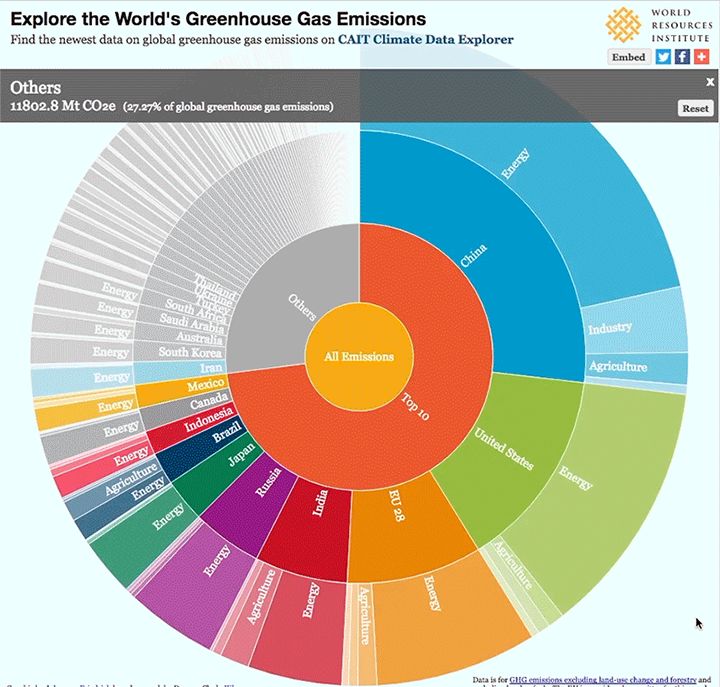

Meg Argyriou, ClimateWorks Australia
One of the ironies of fighting climate change is that developed countries – which have benefited from decades or centuries of industrialisation – are now asking developing countries to abandon highly polluting technology.
But as developing countries work hard to grow their economies, there are real opportunities to leapfrog the significant investment in fossil fuel technology typically associated with economic development.
This week, researchers, practitioners and policy makers from around the world are gathered in New York city for the International Conference on Sustainable Development as part of Climate Week. We at ClimateWorks will be putting the spotlight on how developing countries can use low- or zero-emissions alternatives to traditional infrastructure and technology.
Read more: How trade policies can support global efforts to curb climate change
Developing nations are part of climate change
According to recent analysis, six of the top 10 emitters of greenhouse gases are now developing countries (this includes China). Developing countries as a bloc already account for about 60% of global annual emissions.
If we are to achieve the global climate targets of the Paris Agreement, these countries need an alternative path to prosperity. We must decouple economic growth from carbon emissions. In doing so, these nations may avoid many of the environmental, social and economic costs that are the hallmarks of dependence on fossil fuels.
This goal is not as far-fetched as it might seem. ClimateWorks has been working as part of the Deep Decarbonization Pathways Project, a global collaboration of researchers looking for practical ways countries can radically reduce their carbon emissions – while sustaining economic growth.
For example, in conjunction with the Australian National University, we have modelled a deep decarbonisation pathway that shows how Australia could achieve net zero emissions by 2050, while the economy grows by 150%.
Similarly, data compiled by the World Resources Institute shows that 21 countries have reduced annual greenhouse gas emissions while simultaneously growing their economies since 2000. This includes several Eastern European countries that have experienced rapid economic growth in the past two decades.
PricewaterhouseCoopers’ Low Carbon Index also found that several G20 countries have reduced the carbon intensity of their economies while maintaining real GDP growth, including nations classified as “developing”, such as China, India, South Africa, and Mexico.
‘Clean’ economic growth for sustainable development
If humankind is to live sustainably, future economic growth must minimise environmental impact and maximise social development and inclusion. That’s why in 2015, the UN adopted the Sustainable Development Goals: a set of common aims designed to balance human prosperity with the protection of our planet by 2030.
These goals include a specific directive to “take urgent action to combat climate change and its impacts”. Likewise, language in the Paris Climate Agreement recognises the needs of developing countries in balancing economic growth and climate change.
The Sustainable Development Goals are interconnected, and drawing these links can provide a compelling rationale for strong climate action. For example, a focus on achieving Goal 7 (Affordable and Clean Energy) that also considers Goal 13 (Climate Action) will prioritise low or zero-emissions energy technologies. This in turn delivers health benefits and saves lives (Goal 3) through improved air quality, which also boosts economic productivity (Goal 8).
Read more: Climate change set to increase air pollution deaths by hundreds of thousands by 2100
Therefore, efforts to limit global temperature rise to below 2℃ must be considered within the context of the Sustainable Development Goals. These global goals are intrinsically linked to solving climate change.
But significant barriers prevent developing countries from adopting low-emissions plans and ambitious climate action. Decarbonisation is often not a priority for less developed countries, compared to key issues such as economic growth and poverty alleviation. Many countries struggle with gaps in technical and financial expertise, a lack of resources, and inconsistent energy data. More fundamentally, poor governance and highly complex or fragmented decision-making also halt progress.
Explore world’s greenhouse gas emissions by country & sector with updated CAIT #Climate Data Explorer https://t.co/nfaF6W5FoY #actonclimate pic.twitter.com/kDmefuDxrj
— World Resources Inst (@WorldResources) April 11, 2017
![]() It’s in the best interest of the entire world to help developing countries navigate these problems. Creating long-term, lowest-emissions strategies, shaped to each country’s unique circumstances, is crucial to maintaining growth while reducing emissions. Addressing these problems is the key to unlocking the financial flows required to move to a just, equitable, and environmentally responsible future.
It’s in the best interest of the entire world to help developing countries navigate these problems. Creating long-term, lowest-emissions strategies, shaped to each country’s unique circumstances, is crucial to maintaining growth while reducing emissions. Addressing these problems is the key to unlocking the financial flows required to move to a just, equitable, and environmentally responsible future.
Meg Argyriou, Acting CEO of ClimateWorks, ClimateWorks Australia
This article was originally published on The Conversation. Read the original article.




23 Comments
Pingback: รับสร้างบ้านหาดใหญ่
Pingback: biilad rafidain
Pingback: chaga mushroom tea
Pingback: ข่าวบอล
Pingback: วิธีแทงบอลสเต็ป
Pingback: รับทำเว็บไซต์
Pingback: EndoliftX
Pingback: จัดจำหน่าย บุหรี่ไฟฟ้า
Pingback: รับทำ SEO
Pingback: herbal supplements
Pingback: ร้านอาหารพิษณุโลก
Pingback: stedentrip
Pingback: Bowflex revolution home gym price
Pingback: jebjeed888
Pingback: SHOPEE สล็อต
Pingback: som777
Pingback: ทางเข้า lucabet
Pingback: Team Building
Pingback: เป่าฟูหลิง
Pingback: เว็บหวยออนไลน์เชื่อถือได้ เคล็ดลับทำเงินจากหวยบาทละ 1000
Pingback: โรงงานผลิตสปริง
Pingback: บ้านพักคนชรา
Pingback: ทดลองเล่นสล็อต PG168